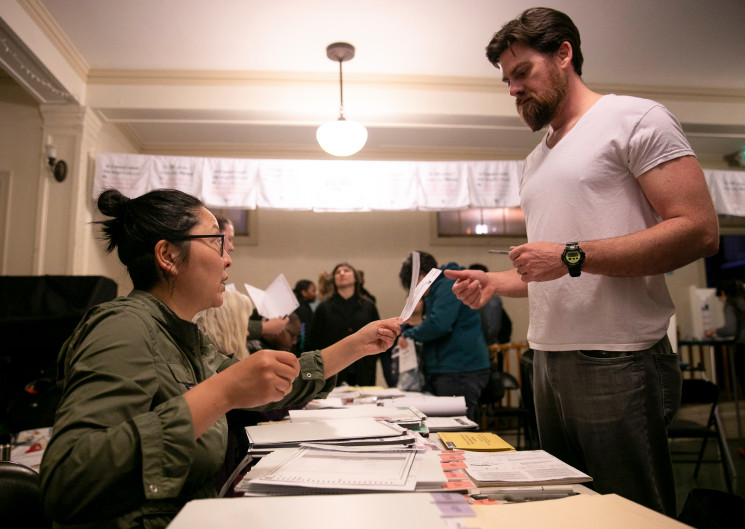Taken at face value, the unprocessed ballots combined with those that have already been counted add up to 8.8 million votes, or a turnout rate of 43% of all registered voters. Of course, this should not be taken at face value.
The results are in. No, not the results you were waiting for, the final tally of California ballots cast for the state’s Super Tuesday presidential primary. We might not have those for days to come and they won’t be officially certified until April.
But this afternoon state officials published their first estimate of how many ballots are left to be counted.
In a state that holds an “election month, not election day” — where results will trickle in for weeks to come, sometimes flipping the outcomes of tight elections in the process — this is an election nerd’s landmark. It also gives us a few more clues about the final shape of California’s various primary contests.
According to estimates published by county election registrars, as of Thursday night, there are 3.5 million ballots left to count. (The Secretary of State’s office showed a count of about 3.3 million, but that did not include the latest updated numbers from Los Angeles County.)
How many ballots left to count?
That small mountain of unprocessed popular will comes courtesy of last minute voters — those who either put their ballots in the mail on Election Day itself, or who voted in person but exercised their California-given right to register or change their political party on the spot.
They also include ballots that were ripped, bent, marred by typos, or that otherwise gave a voting machine a hard time and will thus require the careful study of a human election worker.
What does all of this mean for the various California races still in limbo? We have no idea what all of those ballots say just yet, but this first report offers a few new clues.
Take Vermont Sen. Bernie Sanders current commanding lead over former Vice President Joe Biden. Is there a chance that could narrow in the days to come?
Sanders’ margin over the former vice president is only 271,635. That’s a small fraction of the ballots remaining. Which way will those uncounted vote go? History suggests that the late breaking vote tends to be young, Latino and lower-income — Sanders’ base. On the other hand, there’s evidence that many moderate Democrats were waiting until the last minute to vote and may have rallied to Biden after he was endorsed by fellow centrists Minnesota Sen. Amy Klobuchar and former South Bend, Ind. mayor Pete Buttigieg, after they dropped out.
In other words, as these ballots are counted, they’re likely to run up the margins of both front runners at the expense of the rest of the field.
The other big question hanging over California’s 2020 election is Proposition 13. Can the school bond ballot measure, which is currently down 10 percentage points, recover?
Though these later votes tend to skew left, the school bond would have to win 58% of the ballots left. That is, assuming the estimated remaining ballot count is accurate.
Taken at face value, the unprocessed ballots combined with those that have already been counted add up to 8.8 million votes, or a turnout rate of 43% of all registered voters.
That level of primary electorate vigor falls somewhere in between 2012 and 2016, where turnout was 31% and 47% respectively.
Of course, the estimated number of ballots left to count should not be taken at face value. As long as a mail-in ballot was postmarked by Election Day, any that arrive tomorrow will eventually be counted.
These are also estimates, and pretty rough ones at that. A survey of the ballots left to be tallied shows some suspiciously round numbers: 112,000 in Contra Costa County, 350,000 in San Diego, 80,000 in Fresno.
As Secretary of State spokesman Sam Mahood wrote on Twitter this evening, “It’s still too early to definitively talk about turnout.”
But even as a ballpark figure it suggests that, two days out from Election Day, many California voters have yet to have their ballots counted. In 2016 and 2018, there were more than half a million fewer votes to tally at this point.
That shouldn’t be surprising, according to California Secretary of State Alex Padilla.
In a conference call with reporters before Election Day, Padilla predicted that a higher share of ballots would end up in the late pile this year thanks to a series of recent laws that make it possible for all voters to register to vote or change their party registration on election day itself.
Voters without a registered party were also motivated this year to switch party affiliation or request a special ballot to participate in the presidential primary. That also likely added to the heap of ballots that will take days, if not weeks, to sift through.
By Ben Christopher. Originally published by CalMatters.
CalMatters.org is a nonprofit, nonpartisan media venture explaining California policies and politics.





